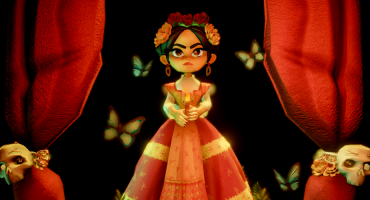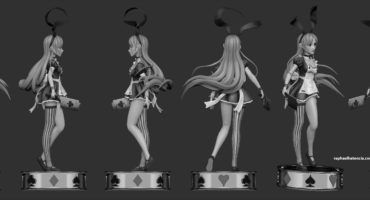
In Art Spotlight, we invite Sketchfab artists to talk about one of their designs.
My name is Charles Coureau, I am a freelance Graphic Designer/Illustrator 2D-3D living in Lyon (France).
Since I was a kid, I have always been attracted by art, illustrations, and video games’ universe, I knew I wanted to work in that field later on. So after High School, I decided to enter the Bellecour Art School in Lyon where I was able to learn drawing, digital painting, and 3D as specialization. I graduated in 2009 and then started to work for several companies as a graphic and 3D designer before becoming a full-time freelancer.
I am now working on various interesting projects such as: the concept art for a video game called Heartz (on sale this December) created by the Upper Byte Studio; environment illustrations; the creation of 3D assets for augmented reality and numerous other upcoming projects.
I am specialized in 2D/3D character design and environment illustrations with a cartoon style. I am always interested in taking part in all kinds of projects and in creating new partnerships. Feel free to contact me for any new project opportunity.
The following lines will give you an overview of how I proceeded to create ‘Tavern Interior’. It’s a personal project which I have used as a good way to practice polygonal and texture optimization. Hope you will find it useful and interesting ;).
Inspiration
First of all, before creating a new work I always start by thinking about what I am going to tell and what will be my references.
For my part, I am a great fan of Diablo and Torchlight, there is a long time I wanted to create decor in the spirit of the Tristram’s Tavern. I like the antique touch given by old wood and stones surrounded by a subdued light which gives a warm and cozy aspect to the scene.
Contraints
This project allowed me to work the optimization as for video games contraints. The challenge was to conceive a 3D decor with limited number of polygons and textures.
- Number of Tris: 12732
- Number of textures: 3 (2×2048) for items + 1x(1024) for walls and beams.
Unlike other works, the exercise wasn’t to separate each items and doing them separately but to gather everything on two maps to optimize my file.
The other requirement was to create textures by digital painting without the use of photographs to establish a more cartoon style. Indeed, all wood and stone textures are digitally painted, using the more commonly known as ’tile’ of textures technique. It’s a good way to save time and work quicker for an interesting result.
Decor construction
To start well and organize the decor’s conception I have to establish the tavern’s size and scale. First, I begin to build a rectangular base of 8 by 12 squares in which I insert a fluorescent green rectangle which I call ‘character’. This green element will help me to build the rest of the scene by giving me a reference scale as if there were a character in the Tavern.
Then, I start to create walls and beams, I display my elements within the scene to give an overall shape and I add some details to give credence to it. When this step is done, I put all my elements on one layer and lock it.
Now, I will be able to start creating all items which will compose and make my scene alive.

Items conception
Before creating items I need to have a clear idea on how I want my scene to be composed. So, I start by decomposing it into areas and define which items I will create and insert within each. Four different areas will compose this scene:
- The entrance with a wooden staircase, barrels and a bookshelf.
- A trapdoor area with boxes, big bags and a plant.
- A dining area with a filled dining table, chairs and a large carpet.
- A fireplace area with a stool, some logs and an axe.
By doing that way it will help me to have an overall idea of what my scene will be and to conceive each items of the scene more easily. After creating every items and placing them into my decor, I can now review my scene and add some details if required which will harmonize the whole scene.

Textures preparation with UV unfolding
When my scene is ready it’s time to unfold it. As said previously, for this step I am creating a common UV unfolding including all my elements and not a texture for each.

Doing that way will be useful for the occlusion map’s step, it will avoid having problems within my textures and also save time.
Then, I use ‘render to texture’ with mental ray and when the 3 occlusion textures are done I’m ready to start painting on them.

Texture
First, I have to create a solid color for each texture to establish a base of color for each item. It will enable to work the color balance having everything in view.
Tip: ‘Thinking about lighting within my scene isn’t important at this stage, the main thing is to stay focus on the textures’.
When everything is done I can now start with details, I add some dirt, imperfections, old screws, dust… which will bring reality to my scene.

Atmosphere
To begin with it, I have to think about where to place the light sources.
The main are from:
- the entrance
- the candle
- the fireplace
For the entrance, I place a spotlight coming from the outside to the inside to draw the light’s outlines. For the candle and the fireplace, I create an omni which I put at the center of the source of light.
The most important work to do isn’t to place the main lights but to create other secondary lights which aren’t here to light up the scene but to bring more subtlety to it. Indeed, four different lights are created to harmonize the scene: an orange, purple, yellow, and blue one. It’s a kind of compositing directly realized with 3ds Max. When this is done, the whole decor is finished.
Rendering
To obtain delicate and realistic lights I work with the rendering engine Mental Ray of 3D Studio Max, easy to use and configure. I do the rendering only when the lights are ready on each textures. In 3D Studio Max, I go in ‘render to texture’ and I select ‘complete map’. Thereby, it will take all UV and add them to the lights and shadows information.

After rendering the 3 maps, I replace the old textures by the new ones. Then, I delete all the lights within my scene and I notice I have a similar result but in this case all is pre-calculated. At the end we have a scene with 12756 tris and no one lights!!
When all is ready, I am using the Sketchfab plugin for the exportation. I make some changes in the settings and all is done.
My discovery of Sketchfab
A friend of mine who is also a graphic designer, recommended Sketchfab to me as he told me it was a great website. As I didn’t know it I had a quick look on it and found the concept very interesting and innovative, so I started to take part in it and share my work with the Sketchfab community. I like the fact it’s very easy to use, you just have to install the plugin on your 3D software, then configure the shaders, lights.. and all is done!
I am curious and looking forward to seeing how the Sketchfab Team will expand their concept in showcasing works of its community.
Thanks Charles!
You can see more of Charles’ work here on Sketchfab as well as on his portfolio site.
On social media, you can follow him on Facebook, LinkedIn, and Twitter.


